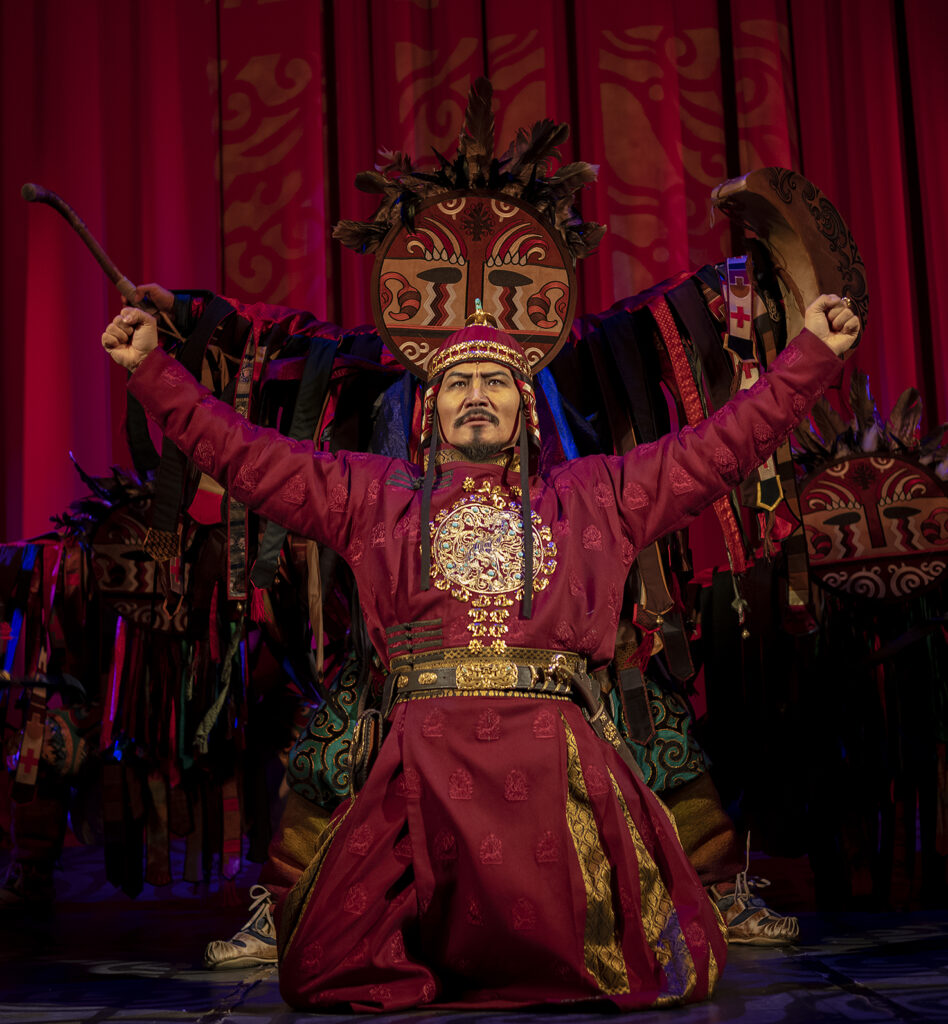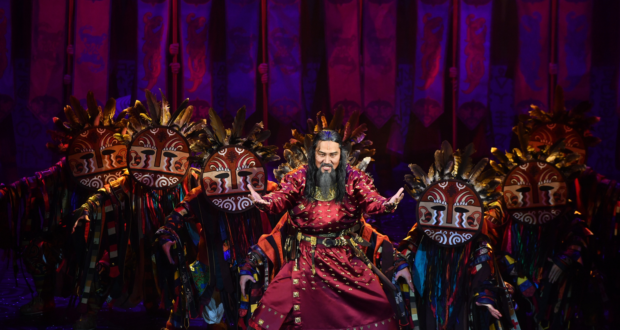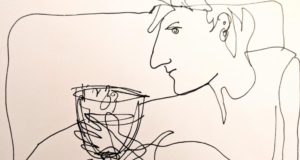The dazzling Mongolian musical arriving in London this November
How do you scale up a 70-strong production in a small Soviet-built theatre to one of the biggest theatres in London? We speak to the creative team behind one of the most exciting shows to come to the West End this year.
Jangling bells and waving long, claw-like nails, two dancers frolic on stage. They wear fox-eared copper helmets and brightly patterned patchwork robes, each with glittery eyes and full red lips. To the beat of the drum, they peel back the curtains and open The Mongol Khan: a new Mongolian musical which is a visual feast of colour, movement and sound.
This July, the show rounded off 151 performances at the Mongolian State Academic Theatre, a modest-sized Soviet-built theatre in central Ulaanbaatar. In November all 70 members of the cast will arrive in London for a limited 2 week run in the West End’s London Coliseum, where it has recently been confirmed that 70 percent of the UK shows will be in Mongolian with surtitles and the other 30 percent in English, so audiences can choose their preference.
The Mongol Khan is the first play to be exported abroad from Mongolia in our lifetimes and is a massive milestone for the country. If it’s a success, it’s likely that the production will be travel internationally, with the director, Hero Baatar, looking to tour it in Europe and elsewhere. It’s not going to be as easy as just taking the show on the road, though. The production was recently banned by Chinese authorities from performing in neighbouring Inner Mongolia, and the show is currently being upgraded to West End standards to make the most of their new stage – all within a very tight timeline.
A remake of the play written in 1998 by late Mongolian writer, Lkhagvasuren Bavuu, The Mongol Khan is a tragedy, considered by locals to be the Mongolian equivalent of Shakespeare. But rather than dramatising the period of history which most of us might associate with the region – Genghis Khan’s Mongol empire – it’s set in the pre-Mongol era, at the start of the Hunnic period. The purely fictional storyline opens with two babies being born on the same day, one destined to be the illegitimate heir to the mighty Khan. A plan to take over the empire unfolds with villainous consequences, and death, drama and despair ensues.
If the epic plot wasn’t entertaining enough, the production ramps up with dozens of dancers, puppets and contortionists, aided by stunning props and costumes influenced by archaeological findings from Hunnu tombs. ‘The costumes in the show are a mix of traditional Mongolian costume and clothes from different civilizations who were living in central Asia,’ explains Hero Baatar, the show’s director. ‘This is the first attempt in Mongolian theatrical history to make historical costumes in a commercial setting.’
Some scenes clearly nod to tradition, with dancers wearing masks and dresses adorned with tassels, bells or feathers, carrying flags and moving collectively as they chant or sing. Then, there are the more abstract interpretations: including the blood vessel-style body suits which dancers wear in some of the highly choreographed scenes. Bold Ochirzhantsan, who designed the costumes, spent two years with her team crafting the outfits for the show, collaborating closely with Mongolian historians, archeologists, artists and craftsmen. ‘Typically, masks are intricately crafted within a span of three to four days, while other costumes may require anywhere from a week to a month for their meticulous creation,’ Ochirzhantsan says. Her team conducted extensive research into the attire of the Hun Empire’s khans, queens, and warriors, and had each character’s costume work in unison as one cohesive ensemble. The result? A gloriously intricate spectacle of colour, which worked with the choreography seamlessly.


Amongst some of the significant changes to the production for the significantly larger Coliseum stage, producers brought the award-winning puppet designer for the West End’s Life of Pi Nick Barnes on board. Barnes was tasked with creating an interpretation of a Mongolian dragon-style puppet, a process that involved collaborating with the Mongolian producers, Myagmar Esunmunkh and Amartuvshin Amundra, from more than 5000 miles away.
Although given a large amount of creative freedom, there has undoubtedly been a learning curve. ‘We had the script and some clips of the original show, so we had a flavour [of the show],’ says Barnes. ‘But there’s very little reference to what a Mongolian dragon might look like: it’s quite contested as to where it originated.’ He explains that a Chinese dragon is far more serpent-like, whereas the Mongolian beast is more akin to a lion or tiger. The puppet is made from a lightweight material which can hold its shape well, as one puppeteer operates it from inside the structure, and another from outside. ‘It’s a great physical challenge,’ says Barnes. ‘They’re both positions which are required to take quite a lot of weight, and will be combined with a very stylized means of performance.’
The stage design for the show – a raked stage, to add depth and platform the different layers of arriving and exiting dancers – will be made up of several panels and lighting systems, as well as curtains, smoke and background video. ‘It’s imperative to adhere to European standards,’ says Ganzorig Dangaa, the art designer. ‘There are differences in stage materials, colours, sound, lighting, curtains, stage dimensions, and technical equipment compared to the usual setups in Mongolian theatres.’
Sound designer for the Coliseum production David Gregory notes that the Ulaanbaatar theatre is well over 100 years old, with far more dated systems than we’re used to. ‘Essentially, they wanted to equip the show from a technical stance using western equipment, because when they take it on the road, they can essentially just copy and paste,’ Gregory explains. ‘A lot of the work I’ve been doing is about how sound can help the storytelling and the synchronicity of everybody together. It’s a massive team, and it’s about the attention to detail of the performance during their dances: they absolutely drill it.’
There have also been challenges from both parties adjusting to cultural differences, such as time frames: Gregory explains that the Mongolian cast are used to being able to extend rehearsals at their leisure, perhaps working to a 16 hour day rather than a 12 hour day. ‘The show has been constantly moving around,’ says Gregory. ‘The Coliseum is one of the largest stages in London, so this [period] has been about learning techniques and equipment that will help them make the job a million times easier in the long run.’
Will they pull it off? The stakes are high: the show is arriving in London to mark 60 years of diplomatic relations between Mongolia and the UK, but with a proven track record on home turf and a dedicated creative team to bring the story to life, we needn’t be worried. The show’s arrival at the Coliseum won’t only be a landmark occasion for Mongolia – it will be one for Britain, too.
The Mongol Khan is at the London Coliseum from 17 November to 2 December. Further information and bookings can be found here.
 Everything Theatre Reviews, interviews and news for theatre lovers, London and beyond
Everything Theatre Reviews, interviews and news for theatre lovers, London and beyond




One comment
Pingback: everything-theatre: “”Inside the design of The Mongol Khaneverything-theatre: “” – Hero Baatar